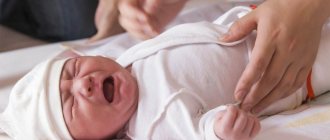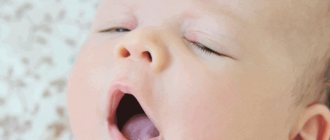Parents help their baby create comfortable conditions from the first days of life. Mothers think through their babies’ sleep down to the smallest detail and try to take into account the opinions of experts. What to do when this opinion differs?
Often mothers have a question: is it possible for a baby to sleep on its side? To figure out what position a baby can sleep in, let's look at different sleeping positions, analyzing the pros and cons.
ON SIDE
+
He sleeps on his side - this position is suitable for children who suffer from colic: the sleeping strong man, with his legs tucked in, finds a comfortable position for passing gas.
+
Lying on the left side (with your head raised 30° - you can put something under the mattress) is a position that alleviates reflux or the problem of spitting up.
—
It is necessary to place the child alternately on the right side and then on the left. Otherwise, torticollis and skull deformation may develop, which will subsequently be difficult to correct.
—
It can easily roll over onto its stomach, which is dangerous for very young children and if the baby does not yet know how to roll over.
—
With dysplasia (underdevelopment of the hip joints), this is an undesirable position for sleeping up to 3-4 months, because there is a load on the hip joints.
ON THE BElly
About 20-30 years ago, the stomach sleeping position was the most common, most parents put their babies to sleep on their stomachs, and pediatricians recommended this position as the safest. But over time, research has shown that this position is unsafe! Sleeping on your stomach increases your risk of developing ADHD significantly! Therefore, we will omit all the possible advantages of this position and present only the disadvantages:
—
A DANGEROUS POSITION, ESPECIALLY FOR CHILDREN WHO STILL DO NOT KNOW TO LIFT THEIR HEAD AND ROLL OVER! A sleeping baby can bury his nose and mouth in the bedding and suffocate!
—
If the baby was born premature or has neurological diseases, then this position can become dangerous for him
—
There is some compression of the chest - it is harder for the baby to breathe.
Infants should not be placed to sleep on their stomach, but it is useful to place them on their tummy every day while they are awake: this way they train the muscular system, develop spatial skills and learn to lift their heads.
SLEEPING ON YOUR BACK
Sleeping on the back is the most common sleeping position for a small child. And the safest.
+
In this position, the sleeping baby is as relaxed as possible, his legs are bent at the knees and spread to the sides, his arms are clenched into fists closer to his face.
+
Lying on his back, an infant can easily move his legs and arms. However, you need to carefully observe the sleeping child. If he moves his arms very actively during sleep and this wakes him up, then it will probably be necessary to swaddle his upper body before bed.
+
Free breathing (no pressure on the chest).
+
Inability to block the nasal passages with foreign objects (pillow or sheet).
+
It’s easy for mom to monitor the baby’s sleep quality and notice possible unpleasant moments (for example, interruptions in breathing).
When laying the baby on his back, it is correct to turn his head to one side, alternating the sides in which you turn the head. This way he won't choke when he burps. And alternate turning from one side to the other will prevent the development of torticollis.
If your baby is absolutely healthy, then this position will suit him perfectly.
—
But placing a child on his back is contraindicated in case of muscle hypertonicity and hip dysplasia. Therefore, consult your doctor!
—
With colic, sleeping on your back makes it difficult for gas to escape, which makes the baby's sleep restless. What helps here is just putting it on your tummy while you’re awake.
In Russia there are no clear documented recommendations on the sleeping position of babies. But Western researchers insist on sleeping on your back as the safest position
during sleep. Previously, it was believed that sleeping on the stomach was an effective position, but according to research results, in this position the likelihood of developing SDV is several times higher!
More than 20 years ago, the American Academy of Pediatricians (AAP) launched an awareness campaign called “Back Sleeping,” which encouraged parents to place their babies only on their backs. The AARP initiated the campaign after a study showed that sleeping on the stomach is dangerous, sleeping on the side is quite unstable and therefore unsafe. Sleeping on your back has been proven to be the safest. A parenting awareness campaign, Back Sleeping, has reduced the risk of sudden infant death by 50%, and about 70% of babies in the United States now sleep on their backs.
A safe sleeping position for a baby is sleeping on his back until the baby learns to confidently roll over on his own.
But there are certain medical conditions for which the doctor recommends a certain sleeping position
, so you should contact your pediatrician and consult with him.
Place your baby on his tummy only when he is awake and only under the supervision of an adult. This helps strengthen the muscle corset and prevent the formation of skull asymmetry.
Thus, before the baby reaches 1 year, it is better to put him to sleep on his back, but remember that as soon as the little one learns to roll over, he can independently change his sleeping position.
Do not limit his movements - stop after 2-3 months: without the help of hands, the child cannot control the position of his head and his breathing.
The choice is, in fact, small: on the back, on the side, on the stomach.
Where to stop?
On the one hand, a number of scientists draw attention to the fact that in the stomach position, children sleep more soundly and wake up less often. The author’s personal experience and observations show that a baby who sleeps on his stomach from the moment of birth begins to hold his head up earlier; During movements, he additionally massages his stomach, making it easier for him to pass gases. With a thick mattress and no pillow, any talk about the possibility of suffocation is simply pointless. It is also unfair to say that without a pillow a child lying on his side will break his neck. If you wrap it with a dozen diapers, maybe it will curl, but if there are only one or two diapers, it will never. When sleeping on your stomach, your head is turned to the side, and this side must be changed every time. Some babies sleep best in the middle position - between on their side and on their stomach - with a diaper placed under their side and folded several times.
On the other hand, without exception, all modern medical guidelines do not even recommend, but categorically state
:
A child of the first year of life should sleep only on his back.
What is such a categorical requirement based on?
The so-called “sudden infant death syndrome” has been repeatedly described in the medical literature. The essence of this terrible and not at all rare phenomenon is as follows. A healthy child dies while sleeping, and no signs of illness are found at autopsy.
Until now, medical science has not been able to unambiguously answer the question of why this happens. The root cause is a sudden stop in breathing, but why does breathing stop?.. Statistics only indicate factors that increase the likelihood of developing the syndrome, but the mechanisms themselves are not completely clear. More often - boys, more often - at the age of 2-3 months, more often - in winter. Unfavorable factors: prematurity, twin child, mother under 18 years of age, less than a year interval between pregnancies, maternal smoking, soft bed, overheating.
However, a factor that statistically significantly increases the likelihood of sudden infant death syndrome is sleeping on the stomach
.
Medical science, having convincingly proven the relationship between sleeping on the stomach and sudden infant death syndrome, still does not have an answer to the question: what actually causes this relationship.
Parents should know that in response to clenching of the nostrils, many babies, especially in the first three months of life, do not try to free themselves, and they stop breathing for 10-15 seconds. Not surprisingly, pillows and soft mattresses can contribute to nostril constriction. In addition, the slightest runny nose in combination with a room temperature above 23 ° C and dry air leads to the formation of dense crusts of mucus, which in turn block the nasal passages and lead to respiratory arrest.
It is very difficult to convince people that pillows are unacceptable, soft mattresses are unacceptable (and it is soft and even crooked mattresses that are often included in children's cribs!). Convincing people that a child should not sleep in a room with warm, dry air is even more difficult. It's easier to write in the media that sleeping on your stomach increases the likelihood of sudden death syndrome.
A child sleeps more soundly in the tummy position.
if there is a pillow;
if the room is dry and warm;
if the mattress is soft and crooked;
if parents smoke;
if you have at least one of these ifs, you should absolutely not sleep on your stomach
!!!
It is a known fact that small children grow up in their sleep, which is why it is so important in the first years of life. During the first year, children are awake very little and spend a lot of time in the cradle.
Proper sleep in the crib
How should a newborn sleep in a crib?
Emotional and physical health depends on how the newborn falls asleep in the crib. The main thing is to ensure that there are no unnecessary objects in it, that the surface is even, smooth, and that the bed linen is clean and ironed. A newborn will sleep more peacefully in a crib than with his parents.
There is no need to completely wrap yourself in a warm blanket, as this can lead to suffocation. A newborn baby will feel more comfortable in a crib if the mother places it next to hers. Not a single newborn baby can fall asleep on his own; at first, mom and dad need to put him to sleep correctly.
How newborns should sleep in a crib:
- the most natural one is on the back. At the same time, turn your head to the side so that the baby does not choke if he burps;
- you can put it on its side, and put a small cushion or a rolled up towel under the back so that it doesn’t turn over;
- If you are not swaddling, put cotton scratch pads on the arms so that hand movements do not wake you up.
Newborns can sleep on their stomachs, however, this position is not advisable. Everyone is different, so parents need to determine the ideal sleep position on their own.
When should a child sleep on a pillow?
In the first year, a pillow is not needed so that the whole body is at the same level. You are allowed to place a thin diaper under your head. The exception is a special “butterfly” shaped pad with a notch in the middle. A simple pillow is placed after reaching two years of age.
At what angle should a newborn sleep?
Make sure that the angle of elevation of the baby's head in relation to his body does not exceed 10 centimeters.
What pillow should a newborn baby sleep on?
There are locking pads that make installation easier. If the baby sleeps in a cradle, a thin diaper folded four times is placed under the head.
Sleeping surface
What surface should a newborn sleep on? Due to the fact that the skeletal and muscular systems of babies are still developing, it becomes clear that a newborn should sleep on a hard surface. Buy a bed made of wood, without irregularities and not varnished.
What mattress should a newborn sleep on?
Pediatricians recommend purchasing hard orthopedic mattresses for infants, because on them the body assumes the anatomical position inherent in nature.
It is important that the mattress is made from environmentally friendly, hypoallergenic materials and ideally matches the size of the bed. The best purchase would be one made from natural coconut fiber and half buckwheat husk. A newborn baby should sleep on such a mattress so that the spine is straight.
Which side of the mattress should a newborn sleep on?
They can be alternated depending on the air temperature in the room where the baby sleeps and his age. Coconut gives a “breathing” effect and is tougher. For older children, you can turn it over to the softer side.
The surface must be smooth, since children are still developing their spine and soft bones. Try to make sure that there are no toys in the crib during sleep, and that the linen is ironed.
In order for the baby to sleep peacefully, it is important for parents to create good conditions for this. It’s good if children get used to their bed from birth. At the same time, buy a good mattress, do not skimp on your health, you don’t need a pillow, and choose a blanket that is not very warm.
What position should a newborn sleep in?
Parents choose what position their newborn baby should sleep in. After all, children do not yet know how to roll over and sleep like adults do.
Pediatricians say newborns can sleep:
- on the back;
- on the stomach;
- on the side.
The parents' task is to ensure that the baby is comfortable and safe in the chosen position. Babies sleep on their backs with their arms up and their heads turned to the side. In this position, babies are most relaxed, but they can frighten themselves with their hands.
Sleeping on the stomach is considered dangerous, but some babies sleep only this way. Parents need to make sure that the baby's head is turned to the side. In this case, you cannot use a pillow to prevent the baby from suffocating. It is better if the child sleeps on his stomach only during the day.
The most comfortable position is considered to be on your side. This is how it is safe for newborns to sleep, because babies will not choke when burping. For convenience, place a cushion from a blanket under the backrest.
In what position should a newborn baby sleep?
Adults can choose in which position a newborn should sleep by observing the child. If he is comfortable, then let him sleep on his back, side or stomach, but you need to ensure the safety of the child. According to pediatricians, lying on your side is the most optimal position for rest.
Sleeping positions and their effect on babies
The position in which you put your baby to sleep can affect his development and health. That is why it is important to choose a position that will be safe and comfortable for the baby.
Sleeping on your stomach
- This position allows the baby to feel a sense of security and comfort;
- it is noted that children sleep much more peacefully on their stomachs;
- the prone position strengthens the muscles of the back, shoulders and neck, which are necessary for developing the skills of turning over and crawling;
- when a child pulls his legs to his stomach while lying on his stomach, the lower limbs are slightly raised, and thus the blood supply to the brain improves;
- the separated legs are in a physiological position, thus reducing the risk of pelvic joint dysplasia;
- in a position on the stomach, body heat loss is reduced, the baby will not freeze;
- positioning on the stomach stimulates the gastrointestinal tract, the baby will be less bothered by colic;
- It is believed that sleeping on the stomach of a baby can cause SIDS (sudden infant death syndrome).
However, despite the above advantages, official medicine does not recommend specifically placing a newborn on his stomach. You can read more about sleeping on your stomach here. As they grow older, starting from 4-5 months, the baby will choose his own sleeping position.
Sleeping on your side
- Pediatricians prohibit placing newborns directly on their side; only babies older than a month can sleep in this position;
- the side position is recommended for babies prone to excessive regurgitation;
- in a position on their side, children pull their knees towards their stomach, this position promotes the passage of gas and reduces the pain of colic;
- if the baby sleeps on his side, change the side on which the baby is lying after each awakening to prevent the development of torticollis and other orthopedic problems;
- when a baby sleeps on its side, the load on the pelvic joints increases;
- from a position on its side, the child can uncontrollably roll over onto his tummy, bury his face in a blanket or mattress and suffocate.
Sleeping on your back
- The position on the back is considered the most physiological and is suitable for newborns;
- To prevent the baby from choking when regurgitating, you need to turn his head on its side when laying him down, changing sides after each awakening;
- the baby, lying on his back, is not limited in his movements, he can freely move his arms and legs, turn his head;
- The supine position is recommended by most pediatricians because this position reduces the risk of SIDS;
- a newborn lying on his back can wake himself up with the movements of his arms, so it is recommended to swaddle him loosely, leaving his legs free;
- If the baby has a stuffy nose, do not put him to sleep on his back, as it will be difficult for him to breathe; shift it so that the baby is on its side;
- The supine position is not recommended for children with pelvic dysplasia.
Side position
Which side should a newborn sleep on?
It is not recommended to leave the baby on one side for a long time. The baby is turned over from one side to the other after 2-3 hours. This is required for the correct formation of the newborn’s skeleton. During daytime sleep, change the side each time you lay down.
Why should a newborn sleep on its side?
Resting in this position is safe, because when burping, the baby will not choke on milk. The newborn will sleep completely peacefully all night on his side, because he breathes freely.
How long should a newborn sleep on its side?
It is very comfortable to rest on your side, but the newborn needs to be periodically turned to the opposite side. Babies sleep on their sides for about 3 months. As children grow up, they learn to roll over and take a comfortable position.
How should a newborn sleep in a stroller? The conditions for sleeping in a stroller should be the same as in a crib. A hard mattress is placed in the stroller, and a folded diaper can be placed under the head. The baby will not need a pillow. In a stroller, babies mostly sleep on their backs. During the walk, parents should close the stroller from drafts and dress the baby according to weather conditions.
Newborn sleeps on its side
It should be noted right away that it is not recommended for a newborn to sleep on his side, since the baby from this position will roll over onto his tummy, which is not safe for him. Therefore, we are talking, rather, about laying it on the half-side : a folded blanket or towel is placed under the backrest.
Despite the fact that this position eliminates the risk of the baby choking in case of regurgitation, children who are barely a week old should not sleep on their side. And all because in this position the load on the hip joints . Therefore, it is better to start practicing sleeping on your side after the end of the newborn period.
However, if the baby suffers from colic, then it is permissible to place him on his side during a short nap. In this position, the child presses his knees to his tummy, which improves the passage of gases.
How should a baby sleep by month?
1 month. You need to prepare a crib or stroller in advance so that a month-old baby can sleep separately from its parents. Pediatricians do not recommend putting children in bed with adults. This is dictated by the safety of the baby, because parents can unwittingly harm him.
A firm mattress is placed in the crib so that the skeleton is formed correctly. Children under 1.2 years old do not need a pillow; it is better to buy a thin blanket. At 3 days old, the baby can already wear a sleeping bag. To prevent the newborn from choking when regurgitating, he is placed on his side. A newborn must change position every few hours.
At what temperature should a newborn sleep?
The optimal temperature in the bedroom ranges from 18 – 23 degrees. The children's room is ventilated before bedtime and drafts are not allowed during sleep. The air must be constantly humidified so that the baby’s nose does not dry out.
What should be the temperature of a sleeping child? During sleep, the baby's temperature rises slightly and is 37 degrees. But there is no need to worry; this is normal.
2-3 months. A 2 month old baby can sleep on his back, but his head must be turned to the side. This position will prevent the baby from choking and oxygen will enter the body faster. A 3 month old baby is already more active and begins to turn his head in his sleep on his own. The baby can be placed on a special orthopedic pillow.
Should my baby sleep after every feeding?
Very often this is exactly what happens, but the correct regimen involves feeding - wakefulness - sleep. Having eaten, the baby actively explores the world and then, tired, falls asleep soundly. And after sleep, when hungry, he sucks the breast much more actively.
4-5 months. The optimal position for a 4-month-old baby to sleep at night is as follows: on his back, head turned to the side, arms raised up, legs bent at the knees.
A mature child at 5 months can already roll over independently and take a comfortable position. Babies can already sleep on their stomachs, butt up, but you need to make sure that they don’t get tangled in a blanket or diaper.
What does the baby's pose say in the video:
What light should a newborn sleep in? During daytime rest, you can close the windows with curtains, but there is no need to create complete darkness. At night, you can leave a dim night light on. It makes it convenient to stand next to your baby for meals and changing clothes.
1 - 2 years. During sleep, the toddler changes position several times, so there is no specific position at this age. He will lie as he pleases.
What pillow should a one-year-old baby sleep on?
Children can rest without a pillow until they are 1.5 years old. If you buy a pillow, it is better to have an orthopedic one. A pillow filled with bamboo fiber, latex, or polyester that fits the width of the crib is suitable.
Where should a 2 year old child sleep? The two-year-old baby is already sleeping separately from his parents in his own bed. At this age, you can move the child to a separate room and teach him to rest alone.
Correct sleeping position and comfortable conditions will ensure healthy and safe sleep for your little one. Taking a close look at the baby, it will immediately become clear which position is most comfortable.
The problems of caring for a newborn occupy an extensive list. They also apply to the baby’s sleep. You should find out whether a newborn can be put to sleep on his back.
Can a baby sleep on his back?
The baby's main pastime is sleeping. It is very important to create the most comfortable conditions and choose the most appropriate sleeping position. There are not so many options - on the back, on the barrel or on the tummy.
Can a one-month-old baby sleep on his back? It is allowed and advisable to sleep on your back for the following reasons:
- the child can turn his head freely;
- there is freedom of action for arms and legs;
- the likelihood of sudden death syndrome is minimized;
- this position is considered the most harmless;
- the baby will not suffocate;
- the chest does not compress;
- this position is considered physiologically natural for the baby.
Proven by scientists through numerous studies:
If the newborn sleeps on his back, this position does not interfere with his development.
An infant should not sleep on his back continuously. You should alternate poses. For example, during daytime sleep, place the baby on his tummy or on his side. During the dark period of the day, it is necessary to place the newborn on his back, so he can sleep all night.
Sleeping on your back
Sleeping a newborn on his back is the most correct from the point of view of his physiology. The baby lies on his back, arms bent at the elbow and clenched in fists, directed upward, legs bent and also spread, head directed to the side. This position is as safe and comfortable as possible for the baby.
To prevent the baby from choking during regurgitation, you should turn the head of the newborn lying on his back to the side. Moreover, with each new position, turn the baby’s head in different directions. This will prevent the development of torticollis. It happens that the baby is more willing to turn his head to one side. In this case, if the baby is turned to the “unloved” side, place a diaper folded in several layers under the back of the head, carefully fixing the position of the head. Each time, reduce the number of layers so that over time you can completely get rid of such a “stand” and teach your baby to turn his head equally to the right and to the left.
However, you should be aware that sleeping on the back may be contraindicated for children diagnosed with hip dysplasia or suffering from intestinal colic.
In addition, a baby who has hypertonicity can swing his arms while lying on his back, hitting himself and waking up from this. In this case, it is better to look for other sleeping positions or securely swaddle the baby.
When can a newborn sleep on his back?
Newborns can sleep on their back from the first days of life. It is advisable to lay in this way until the age of four months.
Is it possible for a newborn to sleep on his back video:
When can a baby sleep on his back?
The baby can be placed on its back to sleep both during the day and at night. When the baby grows up, he will choose the most comfortable position for himself.
The child sleeps only on his back
Newborns should not sleep on their back all the time. This can lead to the formation of torticollis and deformation of the back of the head - it will become flat. If the baby takes this position on his own, it is necessary to change his position.
With the help of folded diapers, you can personally fix the position of the sleeping child. If the baby moves actively, this design will not be effective; insufficiently folded diapers are not safe. Special body position fixators will help you cope with the problem. The products securely fix the child in the desired position; some models are equipped with an indicator of the position of the head and spine, and a motion sickness function.
If your child sleeps with his back arched
, this indicates increased intracranial pressure, hypertonicity of the muscles of the back and neck, severe intestinal colic or nasal congestion, with heavy and difficult breathing. You can get rid of colic and nasal congestion on your own. For other reasons, you should consult a doctor.
Baby sleeps on his back with his head on his side
When the baby sleeps on his back, the baby's head should be turned to the side. This precaution is necessary to ensure that the baby does not choke during the regurgitation process.
The neck muscles are only getting stronger and forming. A newborn is not always able to turn his neck on his own. Therefore, each time you lay out on your back, you need to alternate turning the head in different directions.
If the baby constantly turns his head to one side, it is necessary to control that the head turns change. To do this, you need to roll up a diaper in a certain number of layers, place it under the back of your head and fix the position of your head. The number of layers decreases with each subsequent time, since the child must learn to turn his head equally in different directions.
Baby sleeps on his back with legs bent
When a newborn sleeps on his back, his arms and legs are spread out to the sides and slightly bent. This pose is natural from a physical point of view. Lying on your back is not the only classic baby position. It is worth knowing when to lay your baby on his back, tummy or side. The appropriateness of a particular position must be taken into account in each individual case. Some diagnoses require caution.
Is it possible for a newborn to sleep on his back or side and is there any harm from this?
How should a baby sleep? Is it dangerous for him to lie on his back or side? What happens if a baby burps while lying on his back? Will lying on the side lead to deformation of the baby's neck or skull bones? Is there a sleeping position in which the baby’s body develops faster? We will try to answer these and other questions that concern many young parents today.
Since young children sleep a lot in the initial period of their lives, it is not surprising that their fathers and mothers are concerned about:
- Is their child sleeping in the correct position?
- Should he be allowed to sleep only in the position that the baby has chosen himself, or should he be turned over to another position as soon as he falls asleep?
Yes, the position chosen by the baby largely determines whether his sleep will be sound and healthy. If you take care of this correctly, you will have much less hassle associated with restless sleep, and your baby will get a good night's sleep.
Why is it better to immediately avoid sleeping on your tummy?
It is better to avoid sleeping on the tummy in newborns for safety reasons.
There is no generally accepted opinion among doctors on this matter. There are only recommendations from pediatricians, which are based on many years of monitoring the health of their young patients. At the same time, the Internet is replete with discussions of this issue on various women’s forums, where “digital mommies” share their experiences. And here the opinion of mothers can sometimes differ significantly from the generally accepted recommendations of doctors.
As you know, babies can fall asleep in the same three positions as adults:
- On the back.
- On the side.
- On the tummy.
It is the third option that causes the greatest concern among doctors. It is generally accepted that sleeping on the tummy is one of the factors that can lead to the so-called sudden infant death syndrome (SIDS). As sad (even creepy) statistics say, thousands of newborn babies die every year all over the planet for reasons that are not entirely clear. Healthy children die, and they die in their sleep, because their breathing has stopped.
Unfortunately, doctors have not yet been able to give an exact answer as to why SIDS occurs. In their opinion, there is most likely not one reason - for example, the presence of some “bad” gene, but several. Moreover, it is necessary that all these reasons “successfully” coincide, all at once. And it was noticed that sleeping on the tummy was just one of these reasons.
But at the same time, millions of mothers can give you an example of their children, who slept on their tummy almost from the first day, and nothing happened to them - everyone is alive and well. In this case, it’s worth repeating again: SIDS is not 100% likely to occur in those babies who sleep on their tummy! But it is known that those newborns who did have this syndrome almost all slept on their stomachs. As they say, draw your own conclusions.
What's the best way to proceed?
The safest position for a baby is lying on his back
Most likely, those who say that you cannot take risks by completely trusting nature are right. No matter how beautiful, comfortable and physiological the sleeping position of a child on his tummy may seem to you (fetal position and all that), the most that can be done is:
- be sure to use it if your newborn has problems with the ventricle (colic in this position goes away faster);
- give the baby the opportunity to fall asleep in this position, since he himself is so eager for it, but then immediately shift him to another position, less risky - on his back or on his side, and make sure that he stays in it.
By comparison, think about this: you can avoid using pedestrian zones by crossing the road anywhere, and do so for the rest of your life. If you are careful enough, nothing will happen to you - drivers are not animals to crush you. But you won’t make an example of yourself by insisting that this “stupid” clause about pedestrian zebra crossings be removed from the traffic rules, thereby allowing all people to cross the road wherever they want! Statistics in this case will not be on your side - most often those pedestrians who die on the roads are those who crossed the street in the wrong place.
It is with your child that nothing may happen, and most likely it will happen. But it’s really not worth advising all other parents to do this. There's no need to risk letting your baby sleep on his tummy. The probability of falling into these “terrible” statistics for SIDS will not, as we have already said, be 100%, but will increase significantly.
Supine position - advantages and disadvantages
With the help of a crib, you can protect your newborn while sleeping
The position when the baby sleeps on his back is usually recommended by pediatricians around the world as the least dangerous. The baby in this position is as free as possible. He can move his arms and legs, turn his head as it suits him. The only thing doctors advise is not to let the baby in this position scratch his face. To do this, it is advisable to trim his nails and cover his hands using a vest with long sleeves, or put thin mittens on his hands.
There are also “contraindications” for this position.
- A newborn suffering from a runny nose should not be placed in it. It is difficult to breathe while lying on your back, your nose becomes very clogged, and a swollen nasopharynx also makes it difficult to breathe through your mouth.
- If a baby, after a heavy meal, suddenly begins to burp in his sleep, the vomit may get stuck in his respiratory tract, which is very dangerous.
- In this position, the baby suffers more from stomach colic.
In other words, put your baby to sleep in this position if he doesn’t burp every time after eating. And to protect him, parents need to constantly ensure that the child’s head is turned slightly to one side. In addition, so that lying in one position does not cause any deformation of the still soft bone tissue of the child’s skull, the position of the baby’s head must be changed from time to time.
Let us also add that doctors do not recommend this position for children who have been diagnosed with hip dysplasia. In addition, if the baby suffers from muscle hypertonicity, in his sleep he can swing his arms, hitting himself and waking up from this. In this case, it is better to abandon the sleeping position on the back or swaddle the baby before bed, thereby limiting his movements.
A special ergonomic mattress is perfect for sleeping on your side.
Position when the baby sleeps on his side
In some cases, the position on the side makes the baby sleep more soundly
It is in this position, by the way, that it is mandatory to put a newborn to sleep (babies up to 28 days old are considered this). He still cannot roll over on his own in this position, so the position is considered as safe as possible. Later, when the baby reaches the status of a baby, you can already practice the pose on your back or continue to stick to the pose on your side and beyond.
The pose is suitable just for those negative cases that we described above:
- When children have a runny nose, it’s easier to breathe this way; one of their nostrils will probably clear itself;
- when regurgitating, the vomit rushes out, and the child will simply spit it out, and you will come to the rescue in time;
- In case of stomach colic, in a position on the side, the baby must press his knees to his tummy, so the gas will come out much easier.
One problem is that children will not be able to lie in this position for a long time; they will constantly roll over onto their tummy or back. You will have to provide a special sleeping place for them by twisting thick rolls from towels and placing them under the back and front of the baby. However, you can purchase a special retainer pad. In this case, it will be better to lay the baby not even sideways, but half-sided.
Advice from experienced mothers: since lying in one position can negatively affect the formation of the bones of a child’s skull, after each feeding the baby should be placed on the other side, opposite to the previous one. In order not to get confused, it is better to focus on the breast - often during one feeding the mother gives the baby one breast, and at another - the other. If you have just such a case, then after feeding it is recommended to put the baby to sleep on the side on which breast he sucked before.
If a child constantly sleeps on his side in one position, he may develop torticollis.
How to ensure healthy sleep
Whatever sleeping position you choose for your one-month-old baby, be sure to follow the recommendations that pediatricians give regarding sleeping place. This is what they are.
- The room in which children sleep should be periodically ventilated (during ventilation, the baby is taken to another room). You need to ventilate several times a day.
- The temperature in the children's bedroom should be between 19 and 23 degrees, and the humidity should be between 60 and 70 percent.
- Considering that the sound sleep of babies periodically gives way to restless sleep, you need to dim the lights in the room and also reduce all sounds.
- The mattress in a baby's crib should be hard so that his body does not sink, no matter what position he sleeps in.
- He doesn't need any pillow. You can only slightly raise the mattress at the head of the bed to create a slight tilt for the whole body.
- You only need to swaddle your baby in the initial weeks of his life. Later, he should be put on a loose overall, preferably a cotton one, so that he can move his arms and legs.
- To prevent belching and colic, it is not advisable to put the baby to bed immediately after he has eaten. First, you need to hold him in a “column” for some time so that he burps the air that he swallowed during feeding.
conclusions
Although your baby is just beginning to explore the new world, he quickly develops the most preferred sleeping position. In it he will strive to fall asleep every time if you give him free rein.
Doctors consider positions on the back and side to be the safest, which is why they strongly recommend putting small children in them if they tend to fall asleep on their tummy. But since each position also has some “contraindications,” you must be aware of them if you do not want to harm your child.
How can a newborn sleep on his back?
During sleep, a newborn may jerk its arms or legs sharply. For this reason, the child wakes himself up and may scratch his face. It is advisable to trim your nails in a timely manner.
To prevent your baby from waking himself up, you can swaddle his hands loosely. The baby will think that his mother is hugging him. Also very popular among modern mothers are diapers - cocoons with zippers and Velcro. Thanks to the modern design of the diapers, children sleep soundly and do not wake themselves up during sleep.
Cocoon with zipper
Diaper cocoon - butterfly
Velcro cocoon
Why newborns should not sleep on their back:
- Stuffy nose. If the nose is stuffy, you should not put your child to sleep on his back. In this position, the nasopharynx swells and the throat is partially blocked. As a result, the baby's breathing becomes difficult. In this case, it is recommended to put the newborn to sleep on his side.
- Regurgitation. If a newborn swallows a lot of air while eating, he may choke while regurgitating when sleeping on his back.
- Dysplasia. If your baby has hip dysplasia, it is not advisable to put him to sleep on his back. For this diagnosis, placing the baby on his stomach is used.
- Increased tone. With muscle hypertonicity, the child often waves his arms or legs, which leads to his awakening. In this case, the free swaddling method or the body position on the side or tummy is used.
- Colic and gas. Intestinal colic is considered a common companion for babies in the first months of life. Painful passage of gas leads to restless sleep, crying, and awakening. While sleeping on your back, you need to massage your tummy, place a warm heating pad or diaper on it, and change the position of your body.
- Recession of the tongue. It is necessary to monitor the newborn during sleep, as he may have a recessed tongue.
Many parents are very worried about their baby sleeping turned over on his stomach. Their concern is caused by the fear that the child in this position may suffocate. Therefore, every parent should know exactly all the pros and cons of their baby sleeping on his stomach in order to answer the main question: can a child sleep turning over on his tummy.
There are three arguments against sleeping a baby on the stomach.
Sleeping positions
After the birth of a child, it is mainly mothers who decide how to put him to sleep. Any sleeping position poses a risk to the baby's health.
When sleeping on your side, the joints of the pelvis are compressed, which can lead to dysplasia. During such sleep on the side, parents must turn the baby from one side to the other so that the part of the body on which he sleeps does not become numb. In this position, the baby will not be able to suffocate, since in a position on his side his head will not rest against the pillow or crib. Also, on his side, he will not be able to choke on vomit, since it will easily come off.
On the side, the baby can scratch himself with his arms, since they are next to his face. Also, if the baby sleeps on his side, he can independently roll over onto his stomach, which should not be allowed, because this can damage the still fragile skeletal system.
When a child is used to sleeping on his back, deformation processes may occur in the bones of the skull. This position on the back increases the risk of a situation where the baby may choke on vomit if it enters the respiratory tract. When a child sleeps in this position, mothers must ensure that his head lies on his side.
Also, the head should not be allowed to be constantly on one side; it must be regularly shifted to the other side while the baby is sleeping, otherwise torticollis may develop when sleeping on the back. If the baby has muscle hypertonicity, sleeping on his back will only disturb him; in this case, it is better to turn the baby into a position lying on his tummy.
Positioner for newborns
To securely secure a newborn in a safe position during sleep, you can use not only available means, but also use special devices - sleep positioners .
A support pillow with bolsters is most often intended for sleeping on the side, and special ergonomic mattresses and mattresses with restraints will ensure that the baby sleeps on the back in the most natural position.
It is important to understand that healthy sleep for a newborn means sleeping in a room where the temperature ranges from 18 to 22 degrees Celsius, and the air humidity is at least 60 and no more than 70%. The absence of drafts, loud sounds and bright light also gives the baby a sound sleep.
Add a comment
Misconceptions
Many parents believe that at night, turning the baby's body with emphasis on the pillow provides him with stronger and healthier sleep, protecting him from regurgitation and intestinal colic. However, this opinion is completely wrong. Therefore, in order for the child to sleep peacefully, after feeding he needs to ensure a calm vertical position of the body within 10 minutes.
And the baby should sleep exclusively in an even position on a horizontal surface for the proper development of his spine.
Only at the very early age of the child should mothers control his position, and as soon as he grows up, the baby himself will decide in which position it will be more comfortable for him to sleep. Until this period, the child’s sound and healthy sleep is the merit of his parents, who must listen to the recommendations regarding the development of their baby and select for him the turn that is characteristic of his physical development, as well as age.










